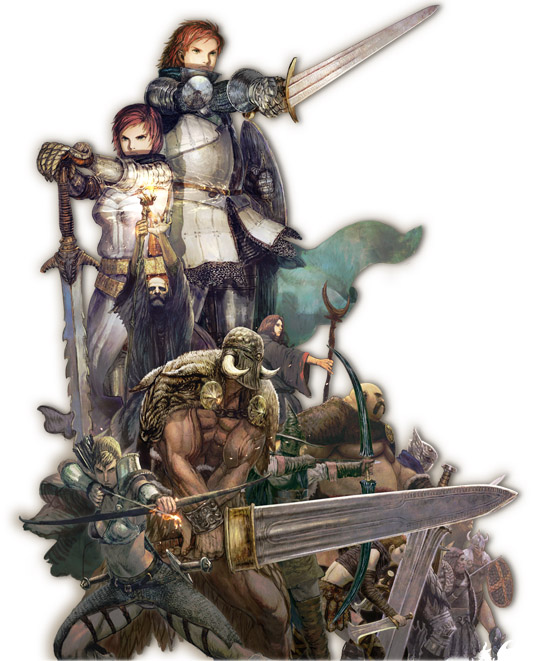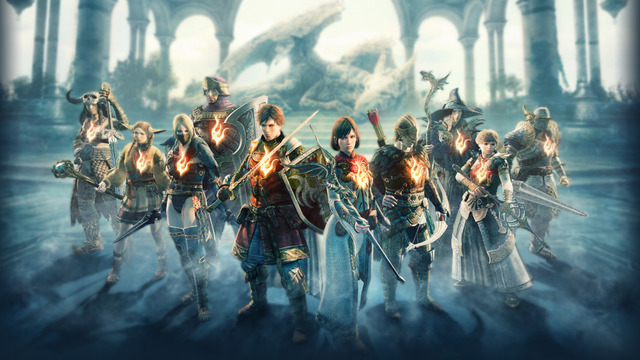Dragon's Dogma: Character Races

After covering occupational templates in some detail, it’s time to look at racial templates. What options do players have for creating non-human characters?
The default answer is “not many”. The original game started out with a more traditional fantasy setting containing all the races you’d expect, but was eventually developed into the setting we see when playing it. Humans make up the bulk of civilization in Gransys and the rest of the world. A minority of alien Pawns are the only non-humans who are also part of it.
There are other non-human sapients around: Goblins and their Hobgoblin cousins clearly have a civilization of sorts, and the various species of Saurian (humanoid lizards) are fairly sophisticated tool-users. However, their views of humanity run between “fun to torment” and “tasty”, with humans holding an equivalent low opinion off them. Peaceful interaction between these species is vanishingly rare. Other sapient monsters (such as the Harpy and Dragon families) are even less appropriate as player characters! These will all be covered when we get to the monsters.
Below you will find two racial lenses for the Arisen and the Pawns. These can be used as-is in the Dragon’s Dogma setting presented in this blog, or in a more traditional DF setting if the GM is willing to bring in the cosmic baggage that comes with them. In those settings, the lenses can be applied to members of any playable race, giving you characters such as elven Arisen or halfling Pawns.
But first, let’s briefly discuss a setting element tied to both of these lenses:
Setting Element: The Rift
The world of Dragon’s Dogma is touched by the Rift, an interstitial realm that appears as a dimly lit, fog-covered plain. The Rift connects multiple worlds, and is the original home of the Pawns. The Dragon comes from somewhere beyond it. The points where it touches the world are marked by Riftstones, and the Arisen can use those to interact with the Rift.
We’ll reveal much more about it in future posts, but for now it’s enough to know that the existence of the two racial lenses shown below in a setting also implies that it’s touched by the Rift and contains Riftstones. GMs using different settings that already possess similar “planar travel” elements might want to use those instead, or to integrate the Rift with them.
The Arisen (10 points)

The Arisen are those who dare stand against the Dragon when it first enters the world. For this, they are marked in a mystical ritual where the Dragon consumes their heart. The stolen heart still beats within the beast, and so the victim rises again compelled to confront it once more.
Having no heart, the Arisen also have no pulse or heartbeat. The ritual also leaves a very large and distinctive scar in their chests, which is the same shape for all of them. This scar can be covered up fairly easily, but it sometimes glows through any clothing or armor when in proximity to a Pawn or a draconic being. The Arisen also have the ability to interact with the Rift by touching a Riftstone. By doing this they are able to draw forth specific Pawns from the Rift itself and the worlds beyond.
They are widely respected in any society that is aware of their existence, but that comes at the cost of being expected to confront the Dragon. Jealous or snobbish nobles also like to impose “tests of skill” to Arisen characters so they might prove they are “worthy” of the station.
The Arisen are portrayed as being unusually capable in the original games, though it is unclear if this comes from their condition or if they were chosen for being heroic in the first pĺace. Either way, Arisen PCs shouldn’t be built on less than 250 points.
It’s worth noting that the ability to drawn Pawns forth from the Rift is a 0-point feature. At most it’s a way of acquiring an Ally (see Arisen Power-Ups below), but usually it’s just fancier dressing for the usual Search rolls to find and hire henchmen.
Advantages: Injury Tolerance: No Vitals (Heart only, -50%) {3}1; Hero 2 {10};
Disadvantages: Unnatural Features (No heartbeat, occasionally glowing scar) {-3}2;
Features: Unaging3; Can interact with the Rift through Riftstones.
Arisen NPCs
The Dragon usually only creates one Arisen per incursion, but it’s definitely possible for more than one to exist at the same time. Even if the party already includes an Arisen PC they might find others who are still hanging around from previous draconic invasions. Their attitudes towards a PC Arisen will vary greatly.
Arisen PCs
An Arisen PC will necessarily bring with it the narrative of the Dragon. It must be addressed, even if it’s just a sentence in the character’s back story explaining how they avoided the confrontation. If it’s publicly known that the character avoided their “fate”, the positive reputation implied by the Hero advantage can be replaced by a negative reputation for cowardice or laziness instead, giving everyone a -2 Reaction and worth -10 points. Simply removing the Hero advantage brings the cost of the lens down to 0 points. Adding the negative Reputation makes it cost -10 points in total.
There’s nothing preventing multiple Arisen PCs from being on the same party! Some of them might be old Arisen created in a previous invasion, or the Dragon might just have decided to be more prolific this time around. It’s not like anyone can stop it from performing the ritual multiple times.
Arisen Power-Ups
Most Arisen tend to acquire the company of an extremely loyal Pawn shortly after being marked, known as their Main Pawn. If this Pawn is an NPC, then it can be bought as an Ally (100% of points, Available Constantly) {20}.
And while not technically a “power-up”, killing the Dragon removes the Arisen lens from all of the Arisen it ever created, returning the hearts it retains to their owners. Such characters retain the loyalty of their Main Pawns and the respect of the rest of the Legion, but become normal members of their base races and immediately age to their natural age. This can cause an ancient Arisen to crumble to dust on the spot, and it’s the main reason why these might be hostile towards their younger “siblings”.
Pawns (-15 points)

Any world subject to the cycle of draconic invasion is riddled with rifts that open to a foggy place beyond it. From these rifts comes the Pawn Legion, familiar yet alien.
Pawns, also known as “Myrmidons”, have no childhood, and no parents. They spring fully grown from the stuff of the Rift. Some are created by an Arisen, others seem to be spontaneously generated, and some are brought over from other worlds. Despite this artificial origin, they are very similar to humans physiologically and still need to eat, drink and sleep as normal. All have a “birthmark” of sorts in the palm of their right hands, shaped like an Arisen’s scar and known as the “pawnprint”. This mark sometimes glows when in the presence of an Arisen.
The main difference between a human and a Myrmidon is psychological. From a human’s point of view, Pawns have a cold and detached demeanor that makes them hard to relate to. They do have emotions and the ability to display them, but the way they do so feels “off” in way that’s hard to describe. They also seem to have a problem displaying significant personal initiative, which is why most of them make a living as errant mercenaries, singly or in small groups. Unlike most standard fantasy races, the average Myrmidon is an adventurer. It’s the “civilians” who are the rare exceptions. Regardless of their profession, all Pawns consider themselves to be members of the “Pawn Legion”, and never fight each other.
Pawns directly created by an Arisen are unflinchingly loyal to their creator, and all Pawns are predisposed to respect any Arisen they meet. They are unaging and have very long memories. Those who feel particularly well-disposed towards their master or employer might offer a constant stream of advice drawn from these memories in an attempt to be more helpful. Fortunately, they can learn to tone it down.
When a Pawn is killed, their body dematerializes. They can be drawn back to life from the Rift by an Arisen. This weakens the Pawn’s metaphysical cohesion, so it can only be done a limited number of times before that individual is lost forever.
Advantages: Eidetic Memory {5}; Extra Life (Requires an Arisen and a Riftstone, -40%) {15}.
Disadvantages: Hidebound {-5}; Low Empathy {-20}; Social Stigma (Minority Group) {-10}.
Features: Unaging3; Reacts at +2 to Arisen; Cannot be resurrected by any other means.
Pawn NPCs
In the original game, all Pawns are AI-controlled characters, and their psychological traits as described above are a justification for their in-game behavior. It’s similarly easy to make them NPCs in a tabletop campaign: any sufficiently-sized city will have a small contingent of Pawns ready to act as hirelings for an adventuring party. They’re a little cheaper than equivalent human help, which compensates for the increased supervision their lack of flexibility requires. Like any hireling, they will refuse to work for a party who purposefully endangers or mistreats them! Word gets around, even among Pawns.
Pawn PCs
PCs can choose to play a Pawn as well. In that case, simply use the racial template above with the same type of template used by the other PCs in the campaign. If another PC is an Arisen, then the Pawn PC will likely be their Main Pawn, and should have a Sense of Duty towards the PC.
If no other PC is an Arisen but someone still wants to play a Pawn, it’s recommended that the GM either change the limitations on the character’s Extra Life or include an NPC Arisen who might perform the service of restoring the dead Pawn. If neither appeal, feel free to delete this advantage and the resurrection-related feature from the racial lens, making it worth -30 points.
Pawn Power-Ups
Pawns who serve an Arisen for a long time or who develop strong relationships with other non-Pawns might find their own souls strengthened by these bonds. They may buy more instances of Extra Life for 15 points each, and Special Rapport with their Arisen creator for 5 points. Additionally, they may buy off the Low Empathy and Hidebound disadvantages from the lens. Extraordinary circumstances might allow a Myrmidon to buy off the entire lens and become a full member of their base race.